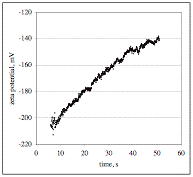288a A Dynamic Model for the Charging of Muscovite Mica In Aqueous Solutions
Muscovite mica is a scientifically important mineral because cleaving it produces an atomically smooth and clean surface for experimentation. While most studies have focused on the equilibrium properties of mica, the advent of a new method for measuring the zeta potential of planar surfaces, the rotating disk, has made possible the investigation of the transient behavior of mica in the first minutes after immersion. The zeta potential of freshly-cleaved muscovite mica (FCM) was recorded within as little as 5 seconds of immersion of the sample and in fractions of a second thereafter. The transient response depended on the composition of the solution. The zeta potential of mica in solution at pH = 5.6 with no added potassium ion exhibited transient behavior with a time constant of approximately 60 seconds. A model including adsorption/desorption of protons and desorption of native potassium ions captures this behavior and makes determination of rate constants possible. KCl solutions of arbitrary concentration caused a more rapid transient response when the pH was alkaline; the zeta potential depended linearly on salt concentration, again in agreement with a model based on adsorption and desorption of potassium ions.
The focus of this presentation is the derivation of the model and its verification. The model describes the first minute of the interaction of mica with solution. Before immersion, a surface concentration of potassium ions SL0 exactly balances the negative charge associated with the mica lattice. This initial value equals Ns (2.17 x 1018/m2), the reciprocal of the area per unit cell, because there is one native potassium ion per unit cell of a freshly cleaved mica surface. After immersion in an aqueous solution containing K+, H+, Cl-, and OH-, physical and chemical changes occur on various time scales. The potassium atoms present at the surface of freshly cleaved mica (SL) progress from the lattice to their positions at the IHP and begin desorbing from the IHP as they become solvated. This desorption proceeds until adsorption of potassium ion from solution balances it. Protons from solution adsorb to the interface until a balance is reached between their adsorption and desorption. Unlike the classic three-layer equilibrium model this dynamic model does not specify where the protons or the potassium ions reside, whether at the IHP or on the lattice itself. As the potassium ions and protons undergo their changes of position, co-ions and counterions from the solution move toward- or away from the surface to provide shielding charge. The electrical double layer, forming on a time scale of microseconds, comprises an outer diffuse charge region and an inner compact charge region. The dynamic mica model assumes the Gouy Chapman Stern Graham (GCSG) description of the inner region of the electrical double layer and a Poisson-Boltzmann dependence of concentration in the diffuse layer. The diffuse part of the double layer is assumed to be in a quasi-equilibrium state at all times.
The equation: Combination of a reaction rate equation, a site balance, and the relationship between uncharged surface sites and the zeta potential leads to the equation below for the case where protons are the only species adsorbing and potassium ions from the native mica are desorbing. Here S- is the surface concentration of exposed negative charge; the overbar indicates normalization by Ns. The parameters kdK, kaH, and kdH are the rate constants (s-1) for potassium ion desorption, proton adsorption, and proton desorption, respectively. The quantities e, F, l, e, R, T are the charge on an electron, Faraday's constant, the Debye length, the permittivity of the solution, the gas law constant, and temperature, respectively.
The graph: In experiments, the zeta potential of freshly cleaved mica samples was acquired over the first 60 seconds after immersion in HCl/KCl solutions. Here the zeta potential increases from a large negative value.
After converting the zeta potential to the concentration of surface charge, a plot in the manner suggested by the equation was generated. Time dependent values of S- were fit to a parabola; the function was differentiated to supply the derivative on the lhs of eq 1 and the function was cubed to provide the abscissa of the graph. The only unknown was the desorption rate constant kdK. It was found that a positive value of kdK indeed made the lhs of eq 1 linear with respect to the cube of the surface concentration of unbound charged sites S-. The order of magnitude of kdK was 10 seconds.
![]()

Web Page: zetaspin.com